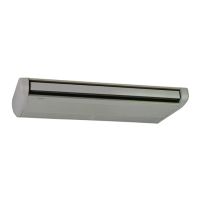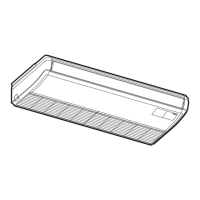9 ADDITIONAL REFRIGERANT CHARGE
9.1 AIR-TIGHT TEST
Check to ensure that spindles of the stop valves for High/Low
pressure gas, Low pressure gas and Liquid pipes are closed com-
pletely before air-tight test.
The refrigerant used for this outdoor unit is R410A. Use the mani-
fold gauge and the charging hose for exclusive use of R410A.
Tightening check of stop valves
After connecting the pipe, remove the caps of stop valves for high/
low pressure gas, low pressure gas (for heat recovery system
only) and liquid. Tighten the open-close spindle in the closing di-
rection according to the following tightening torque.
Caution for operation of stop valves
a. Remove the stop valve caps before performing the air-tight
test after connecting the refrigerant piping. Tighten the
spindle (valve) in clockwise direction according to the fol-
lowing tightening torque.
b. Perform the work after warming the spindle part with a dry-
er etc. when controlling the stop valve in a cold area. (O-
ring of the spindle part will harden at the low temperature
and the refrigerant leakage may occur.)
c. Do not apply an excessive force after fully opening the
spindle. (Tightening Torque: < 5.0N-m) (The back seat is
not provided.)
d. When each valve is opened, remove tags “Close” (Acces-
sories) and attach tags “Open” instead.
e. Tighten securely the caps according to the following tight-
ening torque after each spindle valve is opened.
Stop valve for low
pressure gas
Stop valve
for liquid
Flare nut
Stop valve for high/low
pressure gas
Check joint
(Only the charging hose for
R410A can be connected.)
Hexagonal wrench
High/Low Pressure
Low Pressure: 10 mm
Liquid: 4 mm
(To open or close spindle valve)
O-ring
(Rubber)
Refrigerant
pressure
Spindle valve
Closed before shipment
Counterclockwise...Open
Clockwise...............Close
Cap
(N-m)
Outdoor unit
Spindle (Valve) Flare Nut Cap Check Joint
High/Low pressure
and low pressure
gas valves
Liquid
valve
Liquid
High/low pressure
and low pressure
gas valves
Liquid
valve
High/low pressure
and low pressure
gas valves
Liquid
valve
5 - 12HP 18.0 - 22.0
7.0 - 9.0
33.0 - 42.0
49.0 - 58.0 33.0 - 42.0 9.0 - 14.0 14.0 - 18.0
14/16 25.0 - 31.0 50.0 - 62.0
Air-tight test method
Connect the manifold gauge to the check joints of the liquid line
and the gas line stop valves using charging hoses with a vacu-
um pump or a nitrogen cylinder. Perform the air-tight test. Do not
open the stop valves. Apply nitrogen gas pressure of 4.15MPa for
FSXN1E and FSXNH(E) series. For checking gas leakage, use
the leak detector or forming agent. If there is any leakage, x the
leaking part.
For checking gas leakage, do not use a forming agent which gen-
erates ammonia. Additionally, do NOT use a household detergent
as forming agent whose components are not clear. The recom-
mended foaming agent for checking gas leakage is shown below.
Procedure
Completion
of refrigerant
piping
Applying
nitrogen gas
Check of pressure
decrease
Pass
Repairing of
leakage part
Recommended forming agent Manufacturer
Guproex Yokogawa & CO.,Ltd
DANGER
Be sure to use Nitrogen Gas for air-tight test. If other gases
such as oxygen gas, acetylene gas or uorocarbon gas are ac-
cidentally used, it may cause an explosion or gas intoxication.
49
PMML0294A rev.2 - 07/2014
Additional refrigerant charge
PMML0294A_rev.2_02-2014.indb 49 14/07/2014 12:28:30

